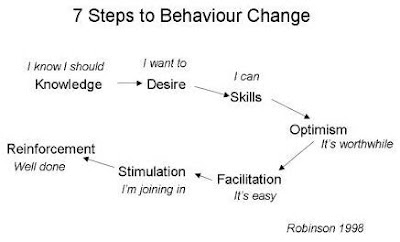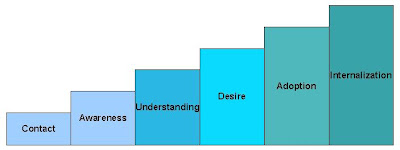Change Management is one of those areas where there are plenty of models floating around, most of them interesting and useful.
Luke Naismith has provided two diagrams of the Robinson model of personal behavioural change.
In the first diagram, Luke illustrates progressive shifts in awareness, capability and confidence during the process of change:
 In the second diagram, Luke turns this around to discuss resistance (or inertia) in response to change:
In the second diagram, Luke turns this around to discuss resistance (or inertia) in response to change:
 as Luke notes, in this second diagram:
as Luke notes, in this second diagram:
Each of these stages needs to be overcome as it could block the embedding of behaviour change in individuals, workgroups, organisations and societies.
In reading Luke’s post, I was struck by the similarities between the Robinson model and the Prosci ADKAR change management model. In ADKAR, there are 5 stages the individual needs to be moved through during change:
- Awareness of the need to change
- Desire to participate and support the change
- Knowledge about how to change (e.g. necessary skills and information)
- Ability to implement new skills and behaviours (e.g. obstacles to enacting the new behaviours, from cultural to legal to organisational should be removed so the person can do it)
- Reinforcement to keep the change in place
In the ADKAR model, as in the Robinson model, people are moved progressively between these stages of awareness, capability and acceptance.
It is also worth noting the similarity of both models to the ‘stages of commitment’ model:
 In the ‘stages of commitment’ model individuals need to be moved progressively higher levels of commitment to the change process: contact, awareness, understanding, desire, adoption, and internalization. I’m not sure where the ‘stages of commitment’ model came from originally – if you know, please leave a comment!
In the ‘stages of commitment’ model individuals need to be moved progressively higher levels of commitment to the change process: contact, awareness, understanding, desire, adoption, and internalization. I’m not sure where the ‘stages of commitment’ model came from originally – if you know, please leave a comment!
For those curious where the Robinson model came from, it was produced in 1998 by Les Robinson of Social Change Media in Australia. Robinson notes:
It began with a thought experiment I carried out in 1998. I asked, ‘What it would take to get me to change my own behaviour?’ . . . The model has [since] been refined from responses in training workshops, consideration of cognitive theories of change; and the results of some formal empirical research that I conducted.
Robinson articulates the current version of his model in the following diagram:
 Robinson discusses his model in detail on the Social Change Media website.
Robinson discusses his model in detail on the Social Change Media website.